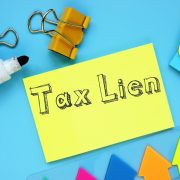FAQs about the Self-Directed IRA for Tax Liens and Deeds
You may have heard that the Self-Directed IRA makes it possible for investors to choose from a wide range of nontraditional retirement assets to keep in their portfolio. Perhaps one of the most intriguing—and nontraditional—of those assets is that of a tax lien. For many investors, the idea of buying up someone’s tax debt sounds like an unusual way to go about real estate investing. But when you familiarize yourself with some of the FAQs, you might recognize why some investors find the idea so appealing:
Question: What is a tax lien?
Answer: A tax lien is what happens when the government issues a claim on a piece of property due to failure to pay taxes. Typically, a lien often means that an individual has a certain amount of time to pay up, or risks forfeiting the property in question to the state. For failure to pay property taxes, the state will issue a lien against the property—and eventually seize it if the individual is incapable of making good on the payments. Tax lien investing is usually focused on real estate transactions like these.
Question: How does tax lien investing work?
Answer: When an investor is interested in a tax lien, it means they might consider purchasing one from the government. Essentially, they are purchasing the asset of the money owed on the property. Typically, if the payments come through on this tax lien, it means higher-than-average interest rates in return. You can find out more about that on our Tax Lien investing page here at American IRA.
Question: What happens if someone does not make the payments?
Answer: When an investor purchases a tax lien, they can get the ambitious returns mentioned above if the individual in debt continues to make payments. But someone usually only misses property tax payments because of money troubles. What happens if this individual or family is incapable of making the payments? In that case, it may be possible for a foreclosure to occur, which means the investor can then hold the property. The investor then has the option of holding the property and renting it out at a profit or selling it.
Question: Why do people invest in tax liens with a Self-Directed IRA?
Answer: For many of the same reasons an investor might choose to invest in real estate with a Self-Directed IRA. For one, tax liens are a way to generate powerful returns in a portfolio. The aforementioned interest rates that investors can collect are often so high that many states set limits on how high they can be. And in the event that the individual responsible for paying the property taxes is incapable of making those payments, the investment essentially becomes a real estate asset for the investor.
Question: What if I do not know a lot about tax liens and real estate?
Answer: The Self-Directed IRA means that you are on your own when it comes to investment decisions, though you would work with a reputable Self-Directed IRA administration firm, which acts as custodian on the account. In other words, you will have more responsibility. This means you will want to consult with tax and investment professionals to get sound advice. At Self-Directed IRA, our role as the IRA administration firm is to serve as custodian, but not to advise you on the best course of action. For many investors, this kind of freedom is up their alley, especially if they have tax lien investing experience.
Interested in learning more about Self-Directed IRAs? Contact American IRA, LLC at 866-7500-IRA (472) for a free consultation. Download our free guides or visit us online at www.AmericanIRA.com.







